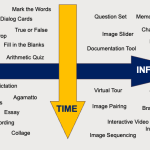H5P
When to use H5P
Everyone’s teaching and learning contexts are different – but one aspect that rings true for all is we don’t want to overcomplicate or introduce elements when they don’t have a purpose. When considering using H5P for your course or resource, evaluate whether it supports the following key principles.
The H5P item
- Aligns with intended learning outcomes
- Allows incorporation of multimedia (multiple modes) to help manage cognitive load during the learning process
- Allows learners to engage with the content to support active learning
The following chart[1] will help you consider how you might use H5P for various teaching and learning purposes.
| Tools for Formative Assessment |
Multiple Choice |
| Tools for Unit/Content Review |
Course Presentation |
| Tools for Multimedia Integration |
Interactive Videos |
| Tools for Student Submissions* |
Questionnaire |
| Tools for Knowledge Application |
Branching Scenario |
* This only includes the H5P content types where students can submit text/media. Students creating and submitting H5P content types that they have authored is a valuable open pedagogy assignment!
Difficulty Level
Activities with more complex interactivity, like Branching Scenarios or Interactive Videos, take longer to create due to the need for careful planning, multimedia integration, and testing to avoid being too complex for your learners.
While more complex content can be engaging, you may want to weigh its cost to benefit ratio. it may take more time to create and could confuse learners if it’s too complicated. [2].

Long Description
A matrix with 4 quadrants. The top left representing less info and less time to create which includes the following H5P content types: Accordion, Find the Words, Drag and Drop, Drag the Words, Flashcards, Mark the Words, Dialog Cards, True or False, Fill in the Blanks, Arithmetic Quiz. The bottom left quadrant represents less info but more time to create which includes: Summary, Dictation, Image Hotspots, Agamatto, Essay, Audio Recording and Collage.
The top right quadrant represents more info and less time to create and includes Question Set, Memory Game, Image Slider, Chart, Multiple Choice and Documentation Tool. The right side bottom quadrant represents more info and more time to create and includes Virtual Tour, Timeline, Branching Scenario, Image Pairing, Interactive Video, Interactive Book and Image Sequencing.
Use Case
Another way of thinking about this is via the following table which lists each H5P content type and their approximate difficulty level to create. The more interactive and media-rich the content, the longer it will likely take to create and refine. Customization requires careful planning and effort. By considering the purpose of each activity, educators can more effectively align H5P tools with their course objectives.
| Simple/Easy | Moderate | Advanced/Complex |
- This chart is adapted from UBC’s H5P Open Hub, Why use H5P? (CC BY-NC 4.0) ↵
- This chart is an adaption of Slide 7, Intro to H5P for Mohawk College by Peggy French, (CC BY-SA 4.0). ↵

